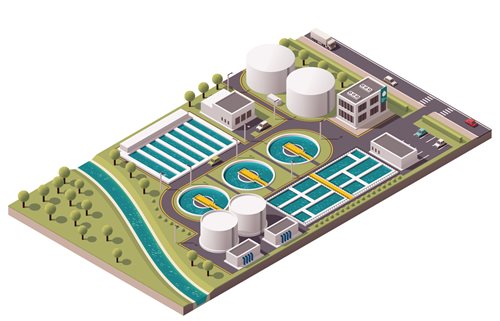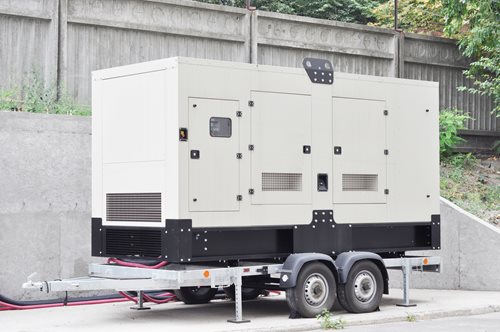Emergency generators keep water districts ready to operate during power outages
What are water utilities?
Water districts and utilities are the infrastructure required to both supply homes and businesses with clean water as well as to remove & clean wastewater. Water utilities can be private entities as well as public agencies, depending on their location. Water districts are comprised of six basic parts:
- Water sources – can include reservoirs, rivers, or lakes, as well as underground aquifers

- Water treatment – facilities that filter and purify water for safe consumption
- Water distribution system – network of pipes, pumps, and tanks that transport clean water to use locations
- Wastewater collection system – the return network that takes gray water and other waste away from source locations
- Wastewater treatment – decontamination systems that remove or treat dirty water so that it can be safely returned to the environment
- Stormwater systems – system of ditches, pipes, and drains to channel precipitation to safe locations
Water utilities also may be called water districts or regions. Municipal water service can be integrated into utilities that provide other services, such as grid electricity or natural gas. Water districts can be either regulated utilities, part of the local government, or private entities. In most states, water utilities have associations, such as the
Colorado Rural Water Association (CRWA), that centralize resources and training for water district managers.
Power redundancy for utilities
A stable electrical supply is essential for modern water districts and utilities to function safely and effectively. This requirement is because positive pressure throughout the system is needed to maintain system integrity. Additionally, power is needed to move water throughout the water distribution and wastewater collection systems. While many water districts utilize tanks elevated above consumers, lift pumps or pump stations may be needed to accommodate changes in elevation or terrain.
Because America’s power grid can be unstable, sophisticated water districts plan for outages through coordination with their local electrical utilities and by backing up key equipment with emergency standby generators. The EPA has published a guide, titled
“Power Resilience: Guide for Water and Wastewater Districts”, to assist water operators with planning for power outages.
Resilient water districts are not just important to maintaining quality of life; they also prevent boil notices and provide fire protection throughout power outages. When water utilities lose system pressure, they increase the opportunity for outside contamination to the water. Contaminated / non-pressurized water can require residents to boil their water before consuming (called a “boil notice”). From a public safety perspective, stable water pressure is important for fighting structural or brush fires. A fire department may use as much as 20,000 gallons of water to fight a large residential house fire – a significant drain on a water system, if pumps are not energized to re-pressurize water mains.
Why do water and wastewater districts need used diesel generators?
Used diesel generators represent the most reliable form of backup electricity for applications that require multiple hours of run time. The diesel stored in the generator unit’s fuel tank provides the water district with 12-24 hours of power. When that used generator is properly maintained and paired with an Automatic Transfer Switch (ATS), the used generator will start when it senses a grid outage and immediately begin providing power to the essential utility equipment.
f71e.jpg)
The
2018 America’s Water Infrastructure Act requires water districts that serve over 3,330 people to develop and maintain emergency response plans. These plans are intended to help water districts think through and prepare responses to natural disasters and power outages. Response plans are directed to include how the utility would respond to an incident and what measures it will take to reduce the risk / impact of a disruption.
What equipment needs to be backed up?
Electric pumps are the most common piece of equipment that water districts back up with diesel generators. These pumps are used to pressurize the water distribution system or move water uphill to other areas or large holding tanks.
Additionally, used generators can be used to back up essential water purification and sewage treatment equipment. This allows new inbound and outbound water to be processed in real time. This is important as holding tanks and waste water facilities generally have limited storage capacity, which could be taxed during an extended power outage.
For regions where extreme precipitation is possible, stormwater pumps may also require a used backup generator to ensure that they continue to function during storms or hurricanes.
Finally, SCATA and other industrial controls / sensors require power to function and will benefit from backup power. Adding emergency generators for control centers or monitoring locations will allow local utility operators to control / view that status of the water district during a power outage.
What types of generators are used?
The generators used by water districts fall into three general categories:
- Diesel emergency backup generators – these standby generators are on-call 24/7 to supply electricity during an outage. When paired with an automatic transfer switch (ATS), they can be called to start without an operator present. The fuel in the tank represents emergency electricity for a number of hours or days.
- Towable portable diesel generators – generators on trailers can be used for routine system maintenance as well as a flex unit during an outage. Some water districts use a single portable generator to cover a number of different pump stations, flexing the generator to the area with outage conditions. Pick-up truck towable generators range in size from 20 kW to 350 kW, with units up to 2MW that can be transported by semi-trucks.
- Small gasoline portable generators – hand portable generators are used to power construction projects or other temporary requirements. These generators can be moved by hand and provide the smallest amounts of power (4 – 17 kW).
Generator maintenance essential for water districts to prepare for power outages
Like all essential equipment, emergency backup generators for water authorities require preventative maintenance to ensure they are ready when called upon. A holistic maintenance plan includes regular preventative maintenance inspections, load bank testing, fluid testing (e.g., oil, coolant), and oil changes. This on-going maintenance program ensures the readiness of the diesel-powered engine as well as the starting components, such as batteries, block heater, and other mechanical components. Finally, regular generator exercises keep parts lubricated and should be standard for any water district generator.
Remote monitoring systems (e.g., BluePillar Onsite Power) can provide water district managers or maintenance personnel with additional information about their generators health and notify them when it turns on. Maintenance managers may also want to consider radiator washing for generators that run regularly or are situated in environments where particles may clog radiators.
Other water authority associations:
Kyle Smith
| 5/6/2021 11:21:26 AM
|
0 comments